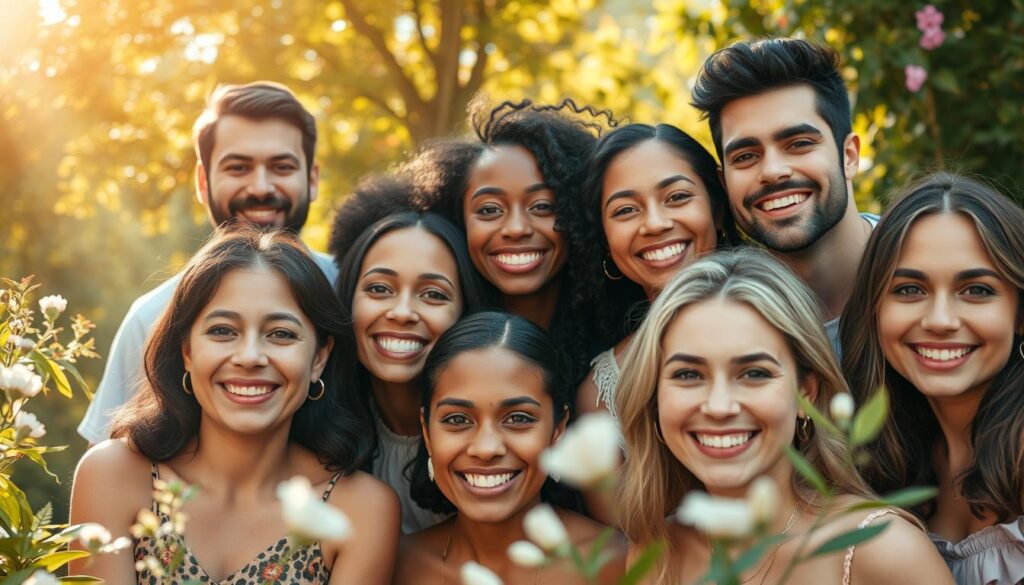Ditch the Beauty Standards – You’re Already Stunning as You Are

Ever feel like you’re constantly chasing an impossible ideal of beauty? Like you’re never quite thin enough, toned enough, or flawless enough? It’s exhausting, isn’t it? The constant pressure to conform to society’s ever-changing beauty standards can leave you feeling inadequate, insecure, and trapped in a never-ending cycle of self-doubt.
But what if there’s another way? What if, instead of striving for an unattainable ideal, we embraced our unique beauty, flaws and all? What if we stopped comparing ourselves to others and started celebrating the incredible individuals we already are?
This blog is an invitation to break free from the chains of beauty standards. It’s a call to reclaim your power, love your body, and embrace your authentic self. Because you are already stunning, just as you are.
Accepting our natural beauty and authentic selves helps us find true self-acceptance and empowerment. By rejecting perfection and embracing our imperfections, we can set our own beauty standards. This helps us overcome the insecurity that has bothered us for too long.

Key Takeaways
- Embrace your unique and natural beauty, rejecting unrealistic beauty standards
- Cultivate self-love and self-acceptance to boost confidence and empower yourself
- Recognize that true beauty lies within, not in external appearance
- Break free from societal pressures and redefine beauty on your own terms
- Celebrate your imperfections and embrace your authentic self
The Powerful Influence of Beauty Standards
Beauty standards have deeply affected people, especially women, throughout history. These standards have changed over time, influenced by culture, society, and economy. From the ideal hourglass figures of the past to today’s focus on youth and flawless skin, beauty ideals keep changing. This leaves many feeling not good enough and struggling to meet these standards.
How Beauty Standards Have Evolved Over Time
The change in beauty standards is complex, influenced by societal norms and economic interests. In the 17th century, fatness was seen as desirable for White women, while African women were seen as less desirable, starting the fear of fatness. Today, the focus is on being young, thin, and looking a certain way, which is hard to achieve naturally.
The Role of Social Media in Perpetuating Unrealistic Beauty Ideals
Social media has made it easier for new beauty standards to spread fast. Social media users often see the same look on platforms like YouTube and Instagram, from fashion to makeup, pushing people to follow certain beauty norms. This has hurt the mental health of many, especially young women, who constantly compare themselves to these unattainable, often edited, images.
Cameron Russel says even models, seen as perfect, can be very insecure. This shows how deep and widespread these beauty expectations are, making them hard to beat.
The writer shares personal stories about beauty standards, showing the pressure to look a certain way, especially from social media. This shows how chasing these unreachable standards can deeply affect us, both mentally and physically.
We need to rethink what beauty and power mean beyond looks. By accepting our unique qualities and challenging old norms, we can start to redefine beauty for ourselves. This can empower us and future generations.
The Dark Side of Beauty Standards
Chasing beauty standards has hurt our mental and physical health. More people are getting eating disorders, feeling anxious, depressed, and stressed. The beauty industry also harms the environment, creating a lot of packaging waste that ends up in landfills and oceans.
The Mental and Physical Toll of Chasing Perfection
About 5.2% of females have eating disorders, says the National Eating Disorders Association. Many teens and adults feel bad about their bodies. There’s a push to fight these beauty standards and support body positivity.
The Environmental Impact of the Beauty Industry
The beauty industry harms the environment too. It uses microplastics in products, which can hurt marine life and us. Every year, it makes 120 billion units of packaging, most of which can’t be recycled and adds to waste.
Chasing beauty standards hurts our mental, physical, and environmental health. We need to rethink beauty and choose sustainability and inclusivity.
“Our bodies are our own. Let’s celebrate the diversity and uniqueness that makes us who we are.”
The Origins of Beauty Standards
In the early 1900s, advertisers started using people’s fears to make money. They moved from selling products for their real uses to selling dreams of beauty. This made them rich by making women feel bad about themselves.
Today, what we see in ads and media shapes how we feel about ourselves. It pushes us towards looking a certain way. This has led some young women to harm themselves, trying to fit an ideal.
How Advertisers Exploited Insecurities for Profit
Edward Bernays and others used tricks to play on our wants and fears. They linked their products to beauty ideals that were hard to reach. This made a lot of money for them and made women feel they weren’t enough.
Beauty standards affect everyone, not just women. But those who don’t fit the mold suffer more. Social media, TV, and movies push these beauty ideals hard. They hurt our body image, self-esteem, and mental health.
“Advertisers and public relations experts used psychological tactics to manipulate people’s desires and insecurities, creating unrealistic beauty standards and associating them with their products.”
A study looked at 30 girls and young women in Ankole, Uganda. It found how society affects their views on beauty and themselves. Parents, friends, and media play big roles in this.
In Ankole, being fat was once seen as a sign of beauty and respect. But now, the beauty ideal has changed to thin and curvy. This has led some young women to harm themselves to look a certain way.
Girls and young women with low self-esteem face big risks. They might deal with depression, suicidal thoughts, eating disorders, and do worse in school.
Beauty Standards And Self Acceptance
In a world obsessed with unrealistic beauty standards, it’s key to accept ourselves as we are. Real beauty comes from within, making each person uniquely stunning. By focusing on our inner qualities and accepting our flaws, we can stop feeling unsatisfied and learn to love ourselves.
Studies show that how we see our bodies affects our self-esteem. A negative view of our bodies can really hurt our self-worth. But, being seen as attractive can boost our confidence. It’s time to challenge these old beliefs and celebrate our inner beauty.
Self-acceptance builds a healthy view of our bodies and boosts our confidence. By being kind to ourselves and focusing on our strengths, we can become more positive about our bodies. Taking care of our bodies is also key to accepting ourselves.
“The most beautiful thing you can wear is confidence.” – Blake Lively
Being around people who support us can help us accept ourselves more. Together, we can move past society’s beauty standards and find our own true beauty.

By accepting our flaws and inner beauty, we grow our self-love and self-esteem. This lets us move through the world with confidence and a new appreciation for our unique beauty.
The Complexities of Women’s Relationship with Beauty
Women’s relationship with beauty is complex and goes beyond just looking good. In our society, being seen as beautiful or feminine can make women feel secure and give them an edge in their jobs and pay. For some, beauty routines and expressing themselves through looks can be a way to take care of themselves or connect with their culture.
But, relying on beauty as a way to fit in can limit and hurt self-esteem. Women in the United States spend a huge $7 billion on cosmetics each year. In 2007, nearly 11.7 million cosmetic procedures were done, which is a huge jump from before (Beauty at Any Cost, 2008).
Trying to meet strict beauty standards, like being thin and Eurocentric, deeply affects women’s mental and physical health. Studies show that women with more body self-consciousness feel worse about their sex lives and have less control (Cash et al., 1989).
Black women face a unique challenge in beauty standards. They often accept bigger body sizes but are still pushed to meet beauty ideals that value Eurocentric looks (Beausoleil, 1992). This creates a tough and sometimes confusing relationship with beauty.
“Women often report feeling self-conscious about their appearance during intimacy, with concerns about being perceived as fat by their partners.”
Women’s views on beauty are complex and influenced by society, culture, and personal choices. As we delve deeper into these issues, we aim for a more inclusive and empowering view of beauty. This view should celebrate the diversity of women’s experiences.
| Key Insights | Data Points |
|---|---|
| Beauty as social currency | $7 billion spent annually on cosmetics in the United States (Beauty at Any Cost, 2008) |
| Pressure to conform to restrictive beauty standards | Nearly 11.7 million cosmetic surgical and non-surgical procedures performed in the United States in 2007, marking a 500% increase over the previous decade (Beauty at Any Cost, 2008) |
| Impact on sexual well-being | Higher levels of body self-consciousness in women linked to lower subjective sexual well-being and agency (Cash et al., 1989) |
| Complexity for Black women | Black women face pressure to fulfill both restrictive hegemonic beauty standards and culturally-specific appearance ideals |
Redefining Beauty on Your Own Terms
We’re now in a new era where beauty standards are changing. It’s time for us to take back our power and set our own beauty standards. Social media has made us talk more about being inclusive, accepting ourselves, and questioning the old beauty ideals.
Becoming a More Mindful and Sustainable Beauty Consumer
One way to redefine beauty is by being mindful and sustainable in what we buy. We should think carefully about our purchases, choose brands that are ethical and green, and look for eco-friendly alternatives. By using up products before getting new ones and supporting sustainable beauty, we can make our beauty choices match our values and help create change.
- Look for redefining beauty brands that support inclusivity and ethics.
- Be mindful in your buying habits by using up products before getting new ones.
- Check out eco-friendly alternatives to lessen the beauty industry’s environmental harm.
- Support brands focused on reducing waste and sustainable beauty.
By choosing wisely as beauty consumers, we help create a future that’s inclusive and sustainable. This future celebrates our unique selves and the many ways beauty shows up in our lives.
“Beauty is not in the face; beauty is a light in the heart.” – Kahlil Gibran
The Dangerous Allure of Rating Attractiveness
In today’s digital world, TikTok’s trend of rating attractiveness from 1 to 10 is worrying. It shows how harmful beauty standards keep spreading. This ranking system makes people think there’s a single, right way to be beautiful. But, beauty is really based on personal likes, cultural views, and what society says is right.
Doing this on social media can hurt self-esteem and make women compare themselves to an unattainable beauty ideal. These actions add to the issue of harmful beauty standards. They also go against the effort to value diversity and each person’s unique beauty.
We need to move past these shallow judgments and see the beauty in everyone. Let’s question the idea that beauty fits everyone the same way. Instead, let’s honor the many ways beauty shows up in our world.
“The root of suffering is attachment.” – Buddha
By focusing on accepting ourselves, we can escape the cycle of comparing. This leads to a better, more positive view of our bodies and looks. This is how we build real self-esteem and find peace.
Let’s stop chasing the idea of rating attractiveness. Let’s celebrate the beauty inside us all. We should aim for a world where we value our differences. This way, we can help each other feel confident and happy in our own skin.
True Beauty Lies Within
In the classic tale of Beauty and the Beast, we learn that true beauty is inside. This story shows us that looks can be misleading. It’s a person’s character, kindness, and inner traits that really count. Just like Belle saw the good in the Beast and fell in love, we should look past looks to see the beauty in ourselves and others.
The Tale of Beauty and the Beast
The story of Beauty and the Beast teaches us that inner beauty is more important than looks. At first, Belle was scared of the Beast because of how he looked. But as she got to know him, she saw his kind heart. In the end, Belle’s love changed the Beast back into a handsome prince, showing that character is more important than looks.
This tale tells us to look deeper and see the real value and beauty in everyone. It says true beauty isn’t about what society thinks, but about a person’s character, kindness, and strength from within.
“The most beautiful thing in the world is, of course, the world itself.”
– Wallace Stevens
By learning from Beauty and the Beast, we can value the beauty inside ourselves and others more. This leads to better self-acceptance and a kinder, more understanding world.

Embracing Your Unique Beauty
It’s time to say goodbye to the unrealistic beauty standards that have ruled us for too long. Let’s embrace the truth that true beauty comes from our uniqueness. Each of us is a one-of-a-kind masterpiece, with our own special features, quirks, and imperfections. These are what make us authentically beautiful.
Learning to love and accept ourselves just as we are unlocks a deep sense of self-confidence and peace. It’s a journey of self-discovery, where we let go of comparing ourselves to others and celebrate the beauty inside us.
- Unfollow social media accounts that promote unrealistic beauty standards and focus on cultivating a positive, uplifting feed.
- Practice gratitude for the things you love about yourself, both physical and non-physical traits.
- Surround yourself with people who uplift and empower you, rather than those who make you feel inadequate.
- Challenge the negative self-talk that stems from insecurities, and replace it with compassionate self-acceptance.
Embracing your unique beauty is a journey, but the rewards are huge. By focusing on self-love and being true to yourself, you’ll shine with confidence that goes beyond how you look. True self-love and confidence are the keys to a life full of joy and fulfillment.
“The most beautiful thing you can wear is confidence.” – Blake Lively
The path to embracing your unique beauty may have its ups and downs, but every step towards self-acceptance and authenticity is a win. Celebrate what makes you different, for those are the qualities that make you extraordinary. Be unapologetically you, and watch as your confidence grows like a rose in full bloom.
The Power of Self-Love and Self-Acceptance
In a world obsessed with beauty standards that are hard to reach, finding true self-love and self-acceptance is a bold move. By saying no to the beauty ideals forced upon us, we can escape the cycle of feeling bad about ourselves. This leads us to real confidence and empowerment.
Tess Holliday, a plus-sized model and activist, fights for self-acceptance. She says it’s key to fight against the beauty standards pushed by the beauty industry. These standards make people feel bad and push them to fit into a narrow beauty mold.
“Eff your beauty standards,” Tess Holliday has said for 10 years. She supports body positivity and tells women to love who they are.
Tess Holliday works as a consultant on inclusivity and diversity. She talks about the need for self-care and daily self-love. Her message helps many who feel less than by beauty ideals.
Studies show how harmful these beauty standards can be. They can hurt women’s body image by 100-109%. But, we can change this by defining beauty for ourselves and inspiring others to do the same.
By loving and celebrating our unique qualities, we make the world more inclusive and body-positive. It’s time to let go of narrow beauty standards. Let’s embrace the power of self-love and self-acceptance.
Conclusion
It’s time to say goodbye to beauty standards that tell us how we should look and feel. By loving and accepting ourselves, we can find the confidence to define beauty in our own way. This journey helps us and can change society for the better.
Let’s support each other in celebrating our unique beauty and saying no to unrealistic beauty ideals. The real beauty comes from accepting our differences and valuing who we are. Together, we can make a world where everyone feels good in their own skin.
Now is the time to break free from beauty norms and take back our power. By focusing on self-love and acceptance, we can create a future where everyone is valued for who they are. Let’s celebrate our unique beauty and embrace our true selves.



